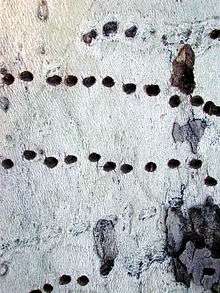Sapsucker
| Sapsuckers | |
|---|---|
 | |
| Scientific classification | |
| Kingdom: | Animalia |
| Phylum: | Chordata |
| Class: | Aves |
| Order: | Piciformes |
| Family: | Picidae |
| Subfamily: | Picinae |
| Tribe: | Dendropicini |
| Genus: | Sphyrapicus S.F. Baird, 1858 |
| Species | |
|
Sphyrapicus varius | |
The sapsuckers are four species of North American woodpeckers in the genus Sphyrapicus.
Taxonomy and systematics
There are four currently recognized species in the genus:[1]
- Red-naped sapsucker (S. nuchalis)
- Red-breasted sapsucker (S. ruber)
- Williamson's sapsucker (S. thyroideus)
- Yellow-bellied sapsucker (S. varius)
The genus name Sphyrapicus is a combination of the Greek words sphura, meaning "hammer" and pikos, meaning "woodpecker".[2]
Description
The members of this genus are slender birds with stiff tails and relatively long wings. Their typical pattern in flight is undulating, alternating between quick bursts of wing beats and short dips with wings tucked against the body.
Behavior
As their name implies, sapsuckers feed primarily on the sap of trees, moving among different tree and shrub species on a seasonal basis. Insects, especially those attracted to the sweet sap exuding from sap holes, are often captured and fed to the young during the breeding season. The most easily recognized sap holes are found in birch trees during the breeding season.
Because sapsuckers attack living trees, they are often considered a pest species.[3] Intensive feeding by sapsuckers is a cause of severe tree damage and mortality, with certain tree species more adversely affected by feeding than others. A USDA Forest Service study found that 67 percent of gray birch (Betula populifolia) trees damaged by yellow-bellied sapsuckers later died of their injuries.[4] This compares to a mortality of 51 percent for paper birch (Betula papyrifera), 40 percent for red maple (Acer rubrum), 3 percent for red spruce (Picea rubens), and 1 percent for hemlock (Tsuga canadensis).[4]
-

Holes drilled by red-naped sapsucker in Platanus wrightii in Arizona, USA
References
- ↑ "ITIS Report: Sphyrapicus". Integrated Taxonomic Information System. Retrieved 3 May 2013.
- ↑ Jobling, James A. (2010). Helm Dictionary of Scientific Bird Names. London, UK: Christopher Helm. p. 362. ISBN 978-1-4081-2501-4.
- ↑ TATE, J. 1973. Methods and annual sequence of foraging by the sapsucker. Auk 90:840-856.
- 1 2 Rushmore, Francis (1969). "Sapsucker: Damage Varies with Tree Species and Seasons" (PDF). Forest Service Research Paper NE-136. Northeastern Forest Experiment Station, Upper Darby, PA: USDA.